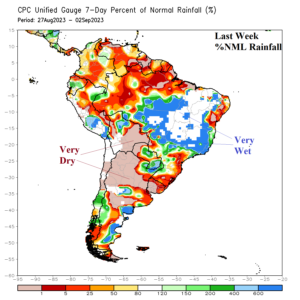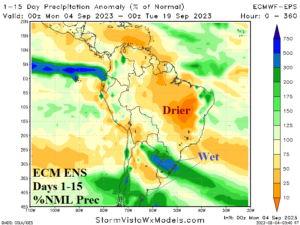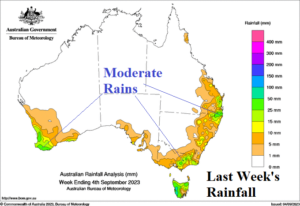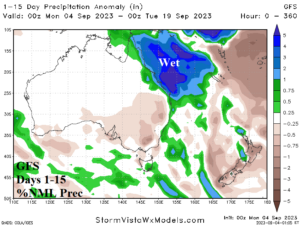Steadily Increasing Cooling Demand for Electricity Markets Early September
08/31/2023, 8:42 am EDTTropical Storm Lee to Undergo “Explosive” Strengthening to a Potential Category-5 Major Hurricane
09/06/2023, 8:14 am EDT

Fig. 1-2: Last week’s percent of normal rainfall and the daily soil moisture anomaly analysis from NOAA.
Discussion: Over-achieving rainfall spread across Brazil during the past week while Argentina was mostly dry (Fig. 1). The soil moisture conditions as meteorological spring arrives features ongoing drought in Argentina/Uruguay, Chile/Peru, and northwest continent (Fig. 2). The 15-day rainfall forecast indicates an almost exact opposite of last week’s rainfall pattern reversing drier in Brazil and wetter across much of Argentina (Fig. 3). The ECM week-3/week-4 ahead outlook maintains a wet Southeast Brazil signature with the primary dry zone across west and northwest Brazil (Fig. 4).


Fig. 3-4: ECM ENS percent of normal rainfall 15-day forecast across South America and the week 3-to-4 rainfall anomaly outlook.
August 2023 was very dry across the southwest and southeast/east continent with only parts of interior Western Australia wetter than normal (Fig. 5). The dry bias to Australia climate caused by El Nino and positive phase Indian Ocean dipole (+IOD) has emerged. Last week there was some isolated patchy moderate rains on the east, southeast, and southwest coast (Fig. 6). The NOAA soil moisture anomaly analysis across Australia reveals drying conditions across northeast New South Wales and southeast Queensland extending southward along the coast plus along the south coast of Australia and westward into Western Australia (Fig. 7). The latest 15-day rainfall forecast indicates a strong upper trough delivering cool weather later this week and through next week to much of the continent. The upper trough causes heavy rain on the Northeast Coast while the remainder of Australia is dry (Fig. 8).


Fig. 5-6: The August 2023 rainfall anomalies and last week’s rainfall totals across Australia.


Fig. 7-8: Daily soil moisture anomaly analysis by NOAA for Australia and the GFS 15-day rainfall anomaly forecast.
